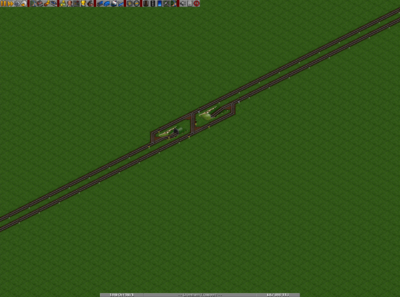Balancing
From #openttdcoop wiki
In our networks we often have lots of tracks that want to join to other lots of tracks. Often the load on the tracks is unequal, so you want to provide incoming tracks with the choice to pick any outgoing line, otherwise you might end up having pretty much empty lines joining to other pretty much empty lines and full lines trying to join to other full lines. The first is obviously fine but you can see the latter might be problematic. Enter: balancing.
Let us clear out some misunderstandings first.
- "The goal you want to achieve by balancing is to have equal loads on every track."
This is not true. Mainlines are built for 100% capacity so it's not a problem when you have a two-track mainline with one track that is 40% loaded and one that is 90% loaded. The problem emerges when you try to join a 70% loaded track to an 80% loaded track.
- "I don't have to balance this join, traffic is already balanced."
The point I made before also shows this assumption is wrong; balancing is not about achieving equal loads. This is also why constructions such as the one below are completely pointless.
Balancing in text
If you want to describe what kind of merge you're talking about, use this format:
- Amount of original tracks + Amount of incoming tracks -> Amount of outgoing tracks
So if you'd have a sideline joining a two-track mainline, you'd have 2+1->2.
So much for the theory, let's get building.
Single-track to single-track: 1+1->1
Of course this is not actual balancing; there is only one outgoing track so you can't provide choice. If you do want to have some control you could add a simple priority line. Or if you're feeling really adventurous you could even throw in a compressor Now let's move on to some more relevant stuff.
Single-track to multi-track: 2+1->2
This is a situation you'll often come across in our games; a sideline joining a mainline at a sideline hub. This is also pretty straight forward, you just want the sideline to be able to pick from every mainline. A potential issue when you start joining to multiple tracks is blocking. Blocking happens when the block between the mainline and the joining line is not large enough to hold an entire train and a mainline train enters the priority section while a train is joining, which then gets stopped and also blocks other trains trying to join. Got that? The image below shows a blocked train.
The solution to this is to eliminate the combo signal, meaning you want every block to be able to hold at least one train.
